|
Bak USA Rugged Seal Tablet
8-inch rugged Windows tablet made in Buffalo impresses with design, features, performance.
(by Conrad H. Blickenstorfer)
Who is Bak USA? Definitely not your typical computer manufacturer. When the company first approached RuggedPCReview.com to take a look at their first rugged tablet, their pitch was that they were comparable to the leading manufacturers, but at 1/3rd of the cost. And that their rugged tablets were built right here in the USA, "using a combination of high tech manufacturing (cobotics) and handcrafted design."
Bak USA doesn't call itself a computer company. It is a "social enterprise that builds computers." The name "Bak" is that of the company's Danish/American founders, an international family who founded a tablet computer company, Sûrtab, in Haiti in 2013, and then Bak USA a year later. Oh, and also a foundation in Haiti to help building homes after the devastating earthquake that hit Haiti's capital in 2010.
And now they have, in addition to durable 2-in-1 laptops for classrooms, the Rugged Seal Tablet. It's an 8-inch, IP65-sealed, Intel "Cherry Trail" powered Windows 10 tablet for tough jobs. The image below shows the Seal from the front and all four sides (click on it for a larger view).
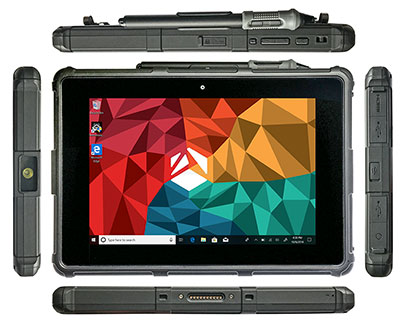
Measuring 9 by 6.1 inches, the Seal has a footprint smaller than that of an iPad. It's 0.8 inches thick and weighs about 1.7 pounds. It comes in an environmentally friendly cardboard box of Apple-esque elegance and attention to detail. There's even an unboxing video.
Out of the box, the Seal feels solid and trust-inspiring. It is very well made, with exemplary fit and finish. It doesn't feel generic. It may be a new kid on the rugged tablet block, but it sure doesn't come across that way. This tablet could come from any of the established, experienced makers of rugged gear.
Where does the Seal fit in? It's an 8-inch design, which, given the latest big-screen phones, is about as small as Windows tablets get. It's powered by a quad-core Intel Atom chip, an x7-Z8700 from Intel's "Cherry Trail" lineup of frugal processors that draw little power and generate little heat. No cooling fan needed here.
Screen
The Seal's display offers 1,280 x 800 pixel resolution, making for 189 pixels per inch. That's nowhere near the insane resolution of today's premium smartphones, but it's pretty much the standard for rugged tablets in this class. While not "retina" level, it's plenty sharp enough.
The display offers near perfect viewing angles from all sides, without any color or contrast changes, tinting, or reduced brightness. Listed luminance is 450 nits (though in our testing we saw only 275 nits). Outdoors, the display remains viewable under most lighting conditions.
Seal active stylus
The Seal tablet comes with an electronic pen, which appears to use Goodix active stylus technology and uses a tiny AAAA battery, has a very thin rubbery tip that's no wider than about 1/20th of an inch. The rubbery tip makes for the kind of friction feeling you get from a real pen. Which makes it much nicer to use than a hard plastic stylus. The pen provides cursor tracking like a Wacom pen does as long as the nib is very close to the display surface. And like a Wacom pen, it accelerates as it approaches the perimeter of the LCD.

The rubbery nibs are replaceable and Bak sells them in sets of 5 ($3) and 25 ($5). Replacement pens cost US$35. We liked the Seal Stylus a lot. And also the snap-in stylus holder mounted on top of the tablet.
Connectivity
What about connectivity? The picture below shows the available interface ports on the right side of the Seal (with their protective covers removed). From left to right, there are a micro-HDMI port, a USB 3.0 Type-C port, a standard USB 3.0 Type-A port, and a 3.5mm in/out audio jack.

If more connectivity is needed, it's available through a US$99 office dock/docking station that comes with plenty of I/O: two USB 3.0, two USB 2.0, two USB fast charging ports, an RJ45 Ethernet jack, HDMI, separate audio in and out, and DVI video.
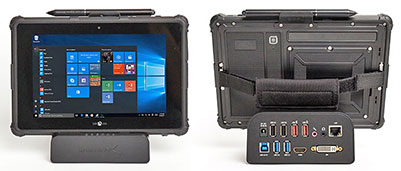
Also available is a Bluetooth keyboard with a built-in foldable stand for the Seal tablet.
A look inside the Seal
It's quite a task to pack a full Windows PC plus battery into a small tablet body, especially when the device also has to be tough and rugged and provide wired connectivity. So we took a look inside to see how the Seal's designers handled that task.
Opening up the tablet is easy, as long as you have various sizes of small Torx screwdrivers for the roughly 20 screws with their small rubber sealing rings. Once those are out, the two black polycarbonate plastic halves easily come apart, with just the stereo speaker wires needing to be disconnected between the sides. Sealing between the halves is via a tongue-and-groove design with replaceable 3D rubber pressure seal.
Compared to many small tablets which are overstuffed with electronics, the Seal looks neat and clean. There is a small 4-1/2 x 3-3/4 inch motherboard with edge-mounted I/O and that's about it. Structural stability and strength is provided by a solid magnesium plate that's screwed onto the front part of the housing. The display and the motherboard attach to that. The metal chassis is meticulously designed and crafted, with wire guides and cutouts.
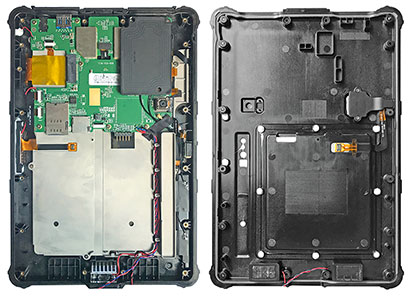
The Seal's 24.4 watt-hour battery is part of a sealed, nicely designed battery door held in place by eight screws. Bak states "5 to 7" hours of battery life. We weren't able to test that as our Batterymon utility didn't work on the Seal. We'd have preferred to see a battery large enough to provide full-shift operation as well as easy hot-swappability of batteries. Inside the battery compartment are also the SIM slot for optional mobile broadband, and a Micro SD card slot.
Unlike in many tablets that are modular in nature, with all sorts of PC-style internal expansion, the Seal's expandability is limited to a micro PCIe slot for an optional WWAN module. What we first thought was a placeholder for an integrated scanner is a flashlight with its own little finned cooling sink. A 1D/2D barcode scanner is optionally available.
Overall, the interior of the Seal leaves a very good impression both in terms of design, manufacturing, execution, as well as fit and finish.
Performance
Intel Atom processors such as the x7-Z8700 are designed to provide enough performance for the kind of general tasks one would use a small Windows tablet for. These chips only cost a fraction of Intel's higher-end and much more complex Core processors, and they don't need a fan. As a result, this class of processors is what's generally used in small rugged tablets. The table below shows the PassMark v6.1 benchmark numbers we recorded, compared to three other rugged 8-inch tablets.
|
PERFORMANCE COMPARISON
|
Bak USA
|
Getac
|
Handheld
|
MobileDemand
|
|
Model
|
Seal
|
T800 G2
|
Algiz 8X
|
T8650
|
|
Year
|
2018
|
2017
|
2017
|
2016
|
|
Processor Type: Intel
|
Atom x7
|
Atom x7
|
Pentium
|
Atom x5
|
|
Processor Model
|
Z8700
|
Z8700
|
N3710
|
Z8550
|
|
CPU Speed
|
1.60 GHz
|
1.60 GHz
|
1.60 GHz
|
1.44 GHz
|
|
Turbo Speed
|
2.40 GHz
|
2.40 GHz
|
2.56 GHz
|
2.40 GHz
|
|
TDP/SDP
|
2 watts SDP
|
2 watts SDP
|
4 watts SDP
|
2 watts SDP
|
|
CPU Mark
|
2,406.3
|
1,620.3
|
2,619.9
|
1,708.7
|
|
2D Graphics Mark
|
104.8
|
104.7
|
173.1
|
135.2
|
|
Memory Mark
|
563.8
|
284.1
|
529.7
|
385.6
|
|
Disk Mark
|
547.4
|
601.1
|
2,518.4
|
847.2
|
|
3D Graphics Mark
|
249.7
|
162.6
|
186.9
|
228.2
|
|
Overall PassMark
|
905.3
|
643.0
|
1,353.1
|
746.5
|
The Seal tablet's performance is where we expected it to be. Ahead of a competitor equipped with a slightly lower end x5-Z8550 processor, and behind a Pentium N3710 powered tablet with a higher power draw and quicker mass storage technology. The Seal is also ahead of a competitor using the same x7-Z8700 processor. In our testing, the unit felt quick and responsive.
Built-in cameras
Like almost all modern tablets, the Seal has front (2-megapixel) and rear (8-megapixel) cameras. The standard Windows 10 Camera app doesn't provide many options and settings, and despite having an 8mp sensor, Windows only allowed up to 3,264 x 1,836 pixel (6-megapixel) images. Video recording is available up to full HD (1,920 x 1,080 pixel) at 30 frames per second. Click on the sample picture compilation to see the image compilation in full resolution.
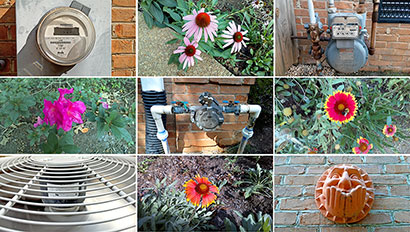
The camera was responsive and worked well, with quick autofocus. Unlike many such integrated cameras, this one is suitable for documentation tasks on the job. We'd highly recommend, however, using a third party camera app.
Ruggedness
The purpose of a rugged tablet is to bring computing power to the field and on the job, even if that job is in an inhospitable environment. That means the device must be able to handle the kind of spills, bumps, grinds and splashes that might happen out there, and the Seal tablet certainly looks like it can do just that.
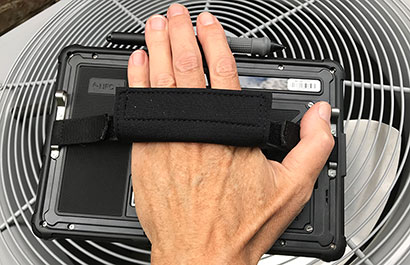
The Seal's data sheet doesn't include a lot in terms of environmental specs. The tablet has a very wide operating temperature range of -4 to 122 degrees Fahrenheit (-20° to +50°C), and ingress protection is at the IP65 level. That means the Seal is fully dustproof and can also handle low pressure water jets from all directions.
The Seal actually looks like it could handle more than that. We had it fully submerged while operating. There was no leakage and the tablet kept on running. The display uses high-strength Corning Gorilla Glass 3, and the glass surface is very slightly recessed into the housing, which provides a bit of extra protection against breakage.
The 4-foot drop spec means the tablet can survive slipping out of one's hands while standing, and crashing onto a hard surface.
Bottom line: Bak USA Rugged Seal Tablet
Bak USA may be an unconventional company and interesting social experiment, but their 8-inch Rugged Seal Tablet is all business. Solid design, well built, quality components and execution, a superior active pen, and class-fitting performance make it a credible alternative to their established competition in the rugged computing market.
We'd like to see comprehensive ruggedness testing results, hot-swapping, and an extended battery option. Else, job very well done, Bak USA. -- Conrad H. Blickenstorfer, October 2018
|



